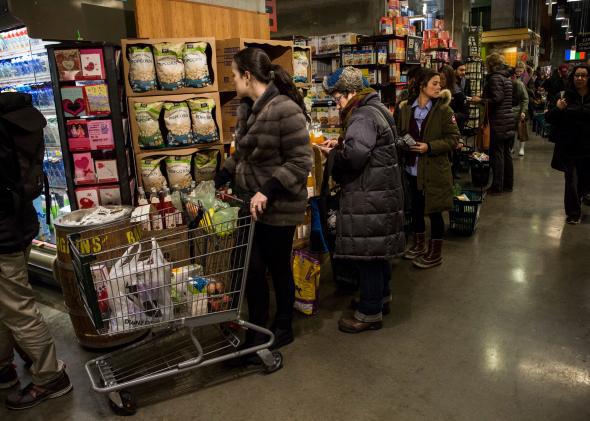It’s mayhem at my local Trader Joe’s right now. The line snakes out onto the sidewalk, and then around the corner. Everyone is desperate to make some last-minute buys, a bag of ginger snaps before the storm. But the shopping frenzy started Sunday, and news reports suggest that supermarket shelves are running bare. According to my Instagram account, boxed salad greens at TJ’s have already disappeared. I don’t want to be accused of yelling fire in a crowded theater, but listen: As of 10 o’clock this morning, there is no more boxed salad at Trader Joe’s.
Anyone who fails to get his groceries in time will face a terrifying situation. A massive blizzard is about to hit New England and the mid-Atlantic, one of the snowiest snowstorms ever to be tallied in the snow books. Public schools may be closed on Tuesday. Flights will be canceled. Certain public-transit lines could be suspended. People living in New York City and other metropolitan hubs will be limited, for at least a little while, in where they go and what they buy. And when that happens—when we’re buried under so much snow—anyone who doesn’t have a box of salad greens will have to wait for half a day or more to buy another box of salad greens.
I don’t mean to say we’re in a panic, but we are behaving like buffoons. Obviously, if people really were afraid of going hungry, they’d be stocking up on batteries and cans of beans and would skip the baby arugula. (Blizzard tip: Salad greens are both perishable and low in energy-content. Don’t buy them.) No, this is a different kind of frenzied state than you’d find during a genuine catastrophe—less frightened than nervously excited, not so much survivalist as shopaholic. In fact there’s a name for such behavior, which takes prudence as a beard for gluttony. The word is hunkering, in the specifically American sense of digging in and taking shelter. It’s the anxious form of self-indulgence, where fear is fuel to make us cozy. The end is nigh … let’s eat!
Official weather warnings feed this hunker culture. They talk in terms of quantity, not quality—an implicit exhortation to go shopping. Meteorologists say that a crippling and historic storm will dump several feet of snow or more. “More”—that’s what drives the hunkered mind: The weather will be so excessive, with so much snow on top of snow, that we should take excessive action. Politicians gin up excessive numbers, the bigger the better: We’ve got 700 pieces of equipment at the ready, says Boston’s Mayor Marty Walsh, and more than 35,000 tons of salt. On Sunday, New York City’s Mayor Bill de Blasio rallied local hunkerers with a call for immoderation: “Whatever safety precautions you take in advance of a storm,” he said, “take even more.” Got that? It doesn’t matter what you do, exactly, as long as you do as much of it as possible.
I have no doubt that it’s much better, at a time like this, for the city to have too much road salt than too little. But when we apply the same logic of excess to ourselves, we get caught up in manic hunkering—and supermarket lines that stretch down the block. Do we really need that box of fig-and-olive crisps? Well, no, but too much is better than too little.
I’m all for having fun—Monday night I’ll be making brownies and hot toddies—but I think our gleeful hunkering reveals a treacherous inclination. When someone tells us there’s a tiny chance of near-term inconvenience, we react with inappropriate enthusiasm: Though the snowstorm will be done by Tuesday evening, we stock our pantries with enough food to last a week. It would be easy to attribute this tendency to evolution. Maybe hunkering satisfies a primeval urge to gather up supplies and drag them deep into a cave; perhaps we feast during a storm because our cells expect a long and barren winter. Or maybe it’s the simple fact of what we really want—a bonus Christmas, so we can skip work and overeat.
Now compare our response to winter-weather warnings with those that arise from dire climate-change reports. When someone tells us there’s a major chance of long-term death and devastation, we often react with anger, helplessness, or indifference. Again, there are some easy evolutionary explanations: It could be that our brains are ill equipped to deal with global warming, since the threat is not immediate. But the problem may have less to do with long-term planning than with the unsavory solutions. To fight off climate change, we’re told to engage in self-denial—to eliminate excess and scale back on what we buy and eat. That’s the opposite of hunkering: It’s a call to turn off the heat and air-conditioning, to be less cozy.
Monday morning’s rush on supermarket produce highlights how these tendencies end up being self-defeating. “Historic blizzards” may be coming more often than they used to: The records will soon show that of the 10 largest storms in New York, going back to 1869, fully half occurred since 2003. A modeling study published in September found that climate change could make snowstorms worse, even as it reduces snowfall overall. These facts should worry us to action, but we’d rather hunker down than pony up.
Perhaps the problem isn’t that winter storms give us license to indulge; it’s that other, more important issues don’t. What if we could find a way to hunker over climate change, so that it’s not just terrifying but also kind of fun? I’m thinking of an anti–Earth Day, where everyone hides out at home, drinking beer and eating pretzels and imagining an awful future for the planet—one where supermarket shelves are always going empty, and lines for groceries wrap around the block.
